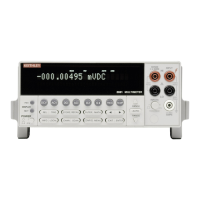Front Panel Operation
3-40
or
SET Ω4 MAX AUTORANGE
200kΩ 20kΩ 2kΩ
2. Highlight the desired maximum range for autoranging
and press ENTER.
Multiple displays
There are three multiple displays available just for the resis-
tance functions:
• Source current
• Voltage drop
• Lead resistance (Ω4 only)
Source current: This is the value of the current being
sourced for the present resistance range. It is based on the
calibration constants and is shown as follows:
Source Current = 0.0000 mA
Voltage drop: This display shows the voltage drop across the
resistance under test. It is shown as follows:
Voltage Drop = 0.0000 mV
This voltage drop is determined by multiplying the source
current by the resistance and does not include voltage contri-
butions from other current that may be flowing through the
resistance.
Lead Resistance: This display, available only for 4-wire
ohms, shows the value of the lead resistance that is being
nulled by using the Ω4 function. You can use the information
to decide if a 4-wire measurement is necessary. The display
is as follows:
Lead Resistance = 0.0000 Ω
If the lead resistance exceeds 1kΩ, the display is:
Lead Resistance > 1000Ω
3.4.4 Frequency
The Model 2001 can make frequency measurements from
1Hz to 15MHz through its INPUT HI and INPUT LO termi-
nals, and from 1Hz to 1MHz through its AMPS and INPUT
LO terminals. Assuming “bench reset” conditions (see para-
graph 3.12.1), the basic procedure is as follows:
1. Connect the test leads to the INPUT HI and LO termi-
nals of the Model 2001. Either the front or rear inputs
can be used; place the INPUTS button in the appropriate
position.
NOTE
A bench reset defaults the frequency input
terminals to INPUT HI and LO.
2. Select the FREQ function.
3. Connect the test leads to the source as shown in Figure
3-16A.
CAUTION
Do not exceed 1100V peak between IN-
PUT HI and INPUT LO, or instrument
damage may occur.
4. Take a reading from the display.
The procedure for measuring frequency with the AMPS and
INPUT LO terminals is similar. (See Figure 3-16B for a con-
nection diagram.) Be sure the frequency function is config-
ured to use the current terminals.
CAUTION
Do not apply more than 2.1A, 250V to
the AMPS input, or the amps protection
fuse will blow. (Refer to paragraph 3.4.2
for the AMPS fuse replacement proce-
dure.)

